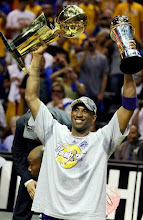After emerging as a potential force in the paint last season, Andrew Bynum looks ready to dominate. After a string of solid performances, Bynum torched the Clippers for a career-high 42 points, on just 24 field goal attempts, on Wednesday night, and followed up that performance with a rock-solid 23-point effort (on just 12 FG attempts) in a blowout win against the Washington Wizards the following night, tossing in 29 rebounds and four blocked shots in the two games, just for good measure. The most exciting aspect of the back-to-back performances, from the Lakers’ perspective at least, is that Bynum doesn’t seem to be playing over his head.
What’s happened in the last two games is not an anomaly, nor has it been absent all season. It just hasn’t happened with this magnitude or with the consistency that many predicted before the season. However, the last two night have given us a glimpse of what Andrew Bynum is expected to become, and looks to be on his way to becoming. A great set of physical tools, combined with his increased physical maturity, added game experience and the tutelage of a legend have Andrew Bynum on the path toward becoming the latest dominant big man in Lakerland.
A legitimate 7-footer, Bynum has done a fantastic job of adding muscle to his once-skinny frame, becoming noticeably more imposing, now tipping the scales at a solid 285 pounds. This strength allows him to hold his own against virtually any NBA big man, but it’s the set of supplemental skills he’s developed that point to Bynum becoming a special player in the near future. Bynum’s combination of length (he has a 7’3” wingspan), soft hands and athleticism (33” vertical leap) are a rarity in man of his size, and have provided his tutor, Lakers legend Kareem Abdul-Jabbar, a full complement of tools with which to work. And that work is paying off, as the skills that Andrew Bynum has developed have Kareem’s fingerprints all over them.
As valuable as Bynum’s size and athleticism may be, what’s now giving him the look of a great big man are his footwork, passing and movement without the ball- hallmarks of Kareem’s dominant career. No longer does Bynum look like “Bambi on ice”, as did in his first two NBA seasons- he’s now identifying the spots on the floor that he wants to get to, getting there, establishing position, and making strong, confident moves once he receives the ball. Rather than allowing him to rely on his considerable, albeit raw, physical assets, Kareem has worked with Bynum, who’s build is very similar to his own, on refining his footwork and always maintaining his balance, which, combined with his ever-improving play without the ball, both on the strong side and the weak side of the floor, have helped Bynum develop a smooth jump hook, a potential go-to move, and to find opening in the paint for easy shots.
Not only has Bynum made great strides with regard to getting his own shot, he’s also improved his passing, both in terms of vision as well as touch. Though he’s not there yet, more than any aspect of his game, Bynum’s passing from the post is reminiscent of Kareem Abdul-Jabbar, who’s widely regarding as one the league’s best-ever passing big men. In an offense so predicated on effective ball movement, Bynum’s ability to find the open man along the sideline, on the perimeter, and cutting down the lane has added another vital dimension to the Lakers offense. With his improved passing, combined with that of Pau Gasol, another excellent passer, the Lakers boast a pair of top-flight passing big men, which keeps defenders honest, and forces far more single-coverage in the post, since neither man has a problem looking over double-teams to find the open man.
After showing flashes of his potential last season, only to be derailed by a dislocated kneecap, Andrew Bynum looks ready to ascend to the next level. While his consistency hasn’t immediately return this season, it’s obvious that Bynum possesses every tool necessary to become a truly dominant big man, and given the way he’s used those tools over the past 48 hours, he seems to be learning how to harness his power.
Less than 18 months ago, Kobe Bryant was livid that GM Mitch Kupchak didn’t send Bynum to


